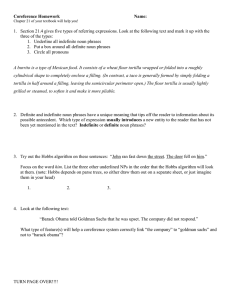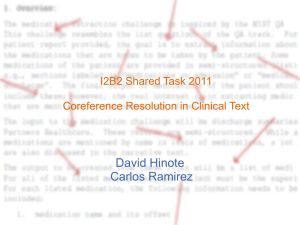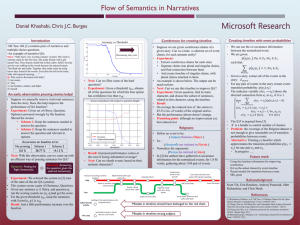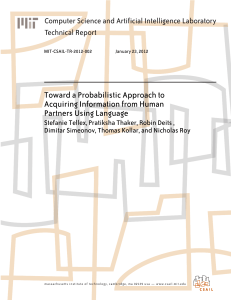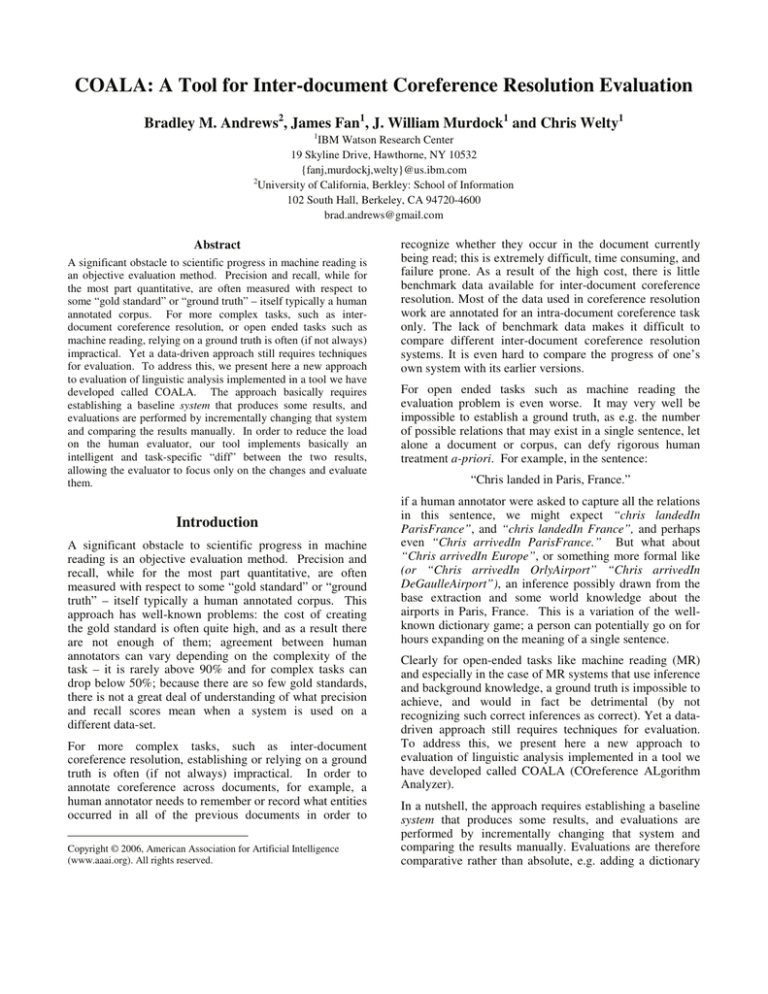
COALA: A Tool for Inter-document Coreference Resolution Evaluation
Bradley M. Andrews2, James Fan1, J. William Murdock1 and Chris Welty1
1
IBM Watson Research Center
19 Skyline Drive, Hawthorne, NY 10532
{fanj,murdockj,welty}@us.ibm.com
2
University of California, Berkley: School of Information
102 South Hall, Berkeley, CA 94720-4600
brad.andrews@gmail.com
Abstract
A significant obstacle to scientific progress in machine reading is
an objective evaluation method. Precision and recall, while for
the most part quantitative, are often measured with respect to
some “gold standard” or “ground truth” – itself typically a human
annotated corpus. For more complex tasks, such as interdocument coreference resolution, or open ended tasks such as
machine reading, relying on a ground truth is often (if not always)
impractical. Yet a data-driven approach still requires techniques
for evaluation. To address this, we present here a new approach
to evaluation of linguistic analysis implemented in a tool we have
developed called COALA. The approach basically requires
establishing a baseline system that produces some results, and
evaluations are performed by incrementally changing that system
and comparing the results manually. In order to reduce the load
on the human evaluator, our tool implements basically an
intelligent and task-specific “diff” between the two results,
allowing the evaluator to focus only on the changes and evaluate
them.
Introduction
A significant obstacle to scientific progress in machine
reading is an objective evaluation method. Precision and
recall, while for the most part quantitative, are often
measured with respect to some “gold standard” or “ground
truth” – itself typically a human annotated corpus. This
approach has well-known problems: the cost of creating
the gold standard is often quite high, and as a result there
are not enough of them; agreement between human
annotators can vary depending on the complexity of the
task – it is rarely above 90% and for complex tasks can
drop below 50%; because there are so few gold standards,
there is not a great deal of understanding of what precision
and recall scores mean when a system is used on a
different data-set.
For more complex tasks, such as inter-document
coreference resolution, establishing or relying on a ground
truth is often (if not always) impractical. In order to
annotate coreference across documents, for example, a
human annotator needs to remember or record what entities
occurred in all of the previous documents in order to
Copyright © 2006, American Association for Artificial Intelligence
(www.aaai.org). All rights reserved.
recognize whether they occur in the document currently
being read; this is extremely difficult, time consuming, and
failure prone. As a result of the high cost, there is little
benchmark data available for inter-document coreference
resolution. Most of the data used in coreference resolution
work are annotated for an intra-document coreference task
only. The lack of benchmark data makes it difficult to
compare different inter-document coreference resolution
systems. It is even hard to compare the progress of one’s
own system with its earlier versions.
For open ended tasks such as machine reading the
evaluation problem is even worse. It may very well be
impossible to establish a ground truth, as e.g. the number
of possible relations that may exist in a single sentence, let
alone a document or corpus, can defy rigorous human
treatment a-priori. For example, in the sentence:
“Chris landed in Paris, France.”
if a human annotator were asked to capture all the relations
in this sentence, we might expect “chris landedIn
ParisFrance”, and “chris landedIn France”, and perhaps
even “Chris arrivedIn ParisFrance.” But what about
“Chris arrivedIn Europe”, or something more formal like
(or “Chris arrivedIn OrlyAirport” “Chris arrivedIn
DeGaulleAirport”), an inference possibly drawn from the
base extraction and some world knowledge about the
airports in Paris, France. This is a variation of the wellknown dictionary game; a person can potentially go on for
hours expanding on the meaning of a single sentence.
Clearly for open-ended tasks like machine reading (MR)
and especially in the case of MR systems that use inference
and background knowledge, a ground truth is impossible to
achieve, and would in fact be detrimental (by not
recognizing such correct inferences as correct). Yet a datadriven approach still requires techniques for evaluation.
To address this, we present here a new approach to
evaluation of linguistic analysis implemented in a tool we
have developed called COALA (COreference ALgorithm
Analyzer).
In a nutshell, the approach requires establishing a baseline
system that produces some results, and evaluations are
performed by incrementally changing that system and
comparing the results manually. Evaluations are therefore
comparative rather than absolute, e.g. adding a dictionary
lookup to some system resulted in a 15% relative increase
in precision. The results will always be relative, since we
don’t require the baseline system to be evaluated. We
don’t consider this a problem, since we believe so-called
absolute precision and recall measures based on a gold
standard are, in fact, relative to the corpus, the linguistic
style of the corpus (e.g. news, blogs, email, fiction, etc),
the task (e.g. NE detection, relation detection, coreference
analysis, MR, etc.), and the inter-annotator agreement.
And furthermore, we don’t know of a better way to
evaluate results in these areas.
The technique still requires manual evaluation of the
results, and our tool, COALA, is designed to reduce and
simplify this load. COALA basically implements an
intelligent and task-specific “diff” between the two results,
allowing the evaluator to focus only on the changes and
evaluate them. In the simple sentence example above, the
evaluator judges the knowledge produced by a system with
some new capability (like an added background KB) rather
than having to imagine all the correct knowledge that could
possibly be extracted from a sentence.
Thus far in our work we have only used COALA to
evaluate progress in coreference resolution. Coreference
resolution is an important part of machine reading in its
own right, and we believe the COALA approach is suitable
for evaluating the wider array of MR techniques as well.
In this paper, we first describe our general research agenda
to combine scalable language technologies with semantic
web technologies, and some aspects of our work on interdocument coreference resolution in order to set the proper
context for our current use of COALA. We then describe
the technique used in the tool for comparing results and
finally some first results in our evaluation of COALA
itself.
The Overall Picture
We have been working on combining large-scale
information extraction from text with knowledge-based
systems. In doing so, we believe we can address the
“knowledge acquisition bottleneck” and extend the
application domain of the extracted information beyond
simple search and retrieval. This is not a new idea;
however our focus is less on theoretical properties of NLP
or KR systems in general, and more on the realities of
these technologies today, and how they can be used
together for large scale inputs.
Architecture
We envision a system made of five main components: goal
analyzer, information extractor, knowledge integrator,
knowledge base and reasoner (see Figure 1).
Goal
Corpus
Query Analyzer
Information Extractor
Knowledge Base
KB updates
Knowledge Integrator
Reasoner
Result
Figure 1: System architecture
Query analyzer
The query analyzer parses a query from the user (e.g., a
natural-language question) and converts it into a formal
representation to be passed on to the reasoner. There has
been a significant amount of work done in this area, and
we are using components that consistently rank in the top
three at competitions such TREC (Chu-Carroll et al. 2005).
Information Extractor
The information extractor annotates entities and relations
found in the corpus, and outputs them. It is made of a
collection of individual annotators embedded in the opensource Unstructured Information Management Architecture
(UIMA) (Ferrucci and Lally 2004). The annotators overlap
to varying degrees in the types of entities and relations they
discover, and in the cases of overlap, need to have their
results combined. The information extractor creates
fragments of knowledge by providing shallow processing,
and it scales linearly with the size of the domain corpus.
Knowledge Base
The knowledge base is a formal representation of both the
domain specific knowledge and top level background
knowledge. The domain knowledge can be obtained from
an authoritative source, such as a subject matter expert or a
text book. The background knowledge can be obtained
from sources such as the Component Library (Barker,
Porter and Clark 2001), CYC, FrameNet and WordNet.
Knowledge Integrator
The knowledge integrator may find implicit relations
between new and prior knowledge; it may link knowledge
fragments produced by the information extractor, and it
may elaborate, confirm or invalidate prior knowledge. The
outputs can be used as updates to the knowledge base, and
they can also be used by the reasoner to produce results for
given goals. A key functionality of the knowledge
integrator is finding the relation between two knowledge
fragments, and coreference (both inter-document and intradocument) resolution is essential for solving this task.
Reasoner
The reasoner takes in the formal representation of a query
and the extracted knowledge integrated with an existing
knowledge base, and it produces a final result. The key
challenge in creating a reasoner suitable for our system is
that the reasoner must tolerate imperfections, such as
knowledge gaps and inconsistencies. Most of the existing
logic-based reasoners require precise inputs, and are
unlikely to return anything meaningful after encountering
imperfect knowledge.
Applications
We believe machine reading systems, specifically
unsupervised text extraction, can benefit from knowledge
integration and inference. MR results linked together
through resources like WordNet and augmented with
background knowledge like geography, political leaders,
etc., can significantly increase the utility of MR over the
MR results alone in applications such as:
Question answering: Unlike most of the current
question answering systems, answers distributed
across multiple documents can be easily found
and retrieved because of the integrated
knowledge. In addition, the knowledge base and
the reasoner provide the facility to compose and
infer answers not explicitly stated.
Search: Current search engines operate on the
assumption that there exists a single document
that contains all the information needed for a
particular search. With the assistance of the
knowledge integrator, this assumption is no longer
needed. Information spread across multiple
documents can be gathered and presented as the
result of a search along with the explanation of
how different pieces are related.
Summarization: Current text summarization
techniques focus on the most relevant words or
sentences in the text. Using our system, we can
analyze the relation between the most relevant
words and the rest of the corpus, and produce
synthesized summarizations that capture the
content of the corpus more naturally and more
thoroughly.
It is important to note, however, that our claims for this
paper are not contingent on our approach to information
extraction and knowledge integration and their connection
to MR, rather we are presenting this material as
background to understanding how we evaluated the
COALA tool.
The Challenge of Efficient Evaluation of
Inter-document Coreference Resolution
As described in the previous section, the knowledge
integrator plays a key role in the proposed system, and
coreference resolution is essential to effective knowledge
integration. However, it is challenging to develop an
effective coreference resolution system, especially for
inter-document coreference. One of the main obstacles is
the high cost associated with inter-document coreference
resolution evaluation. It is easy for a developer to spot a
particular flaw in a set of coreference results, but it is
difficult to evaluate how a system change that fixes that
flaw impacts the results overall. Often we find that
correcting one faulty coreference breaks others.
Coreference Resolution
A coreference occurs when two textual entities refer to the
same conceptual instance. Coreference may occur within a
document, such as the following example.
Scarlett Johansson was born in … She has a sister
named …
The pronoun she refers to the same person as Scarlett
Johansson. Coreference may also occur across multiple
documents such as the following example.
Document 1: President George W. Bush visited …
Document 2: The 43rd president of the United States
gave a speech …
The term President George W. Bush in the first document
refers to the same person as the term the 43rd president of
the United States in the second term.
Coreference resolution is the task of identifying anaphoric
textual entities (she and the 43rd president of the United
States) and their antecedents (Scarlett Johansson and
President George W. Bush). Inter-document coreference
resolution is important because it erases the document
boundary for a variety of tasks. It allows users to gather
information about an entity across multiple documents.
However, inter-document coreference resolution is very
different from intra-document coreference resolution as
many of the intra-document coreference resolution
techniques rely on consistent content and discourse
contextual features, none of which is applicable in interdocument coreference resolution.
Coreference Resolution Evaluation
Coreference resolution evaluation is not easy because it
involves comparing a key made of a set of coreference
chains (a list of words that refer to the same entity) with
the set of coreference chains from the system being
evaluated.
Scoring inter-document coreference has an additional
challenge – there is little annotated data available, hence
there is no key to compare with for the output of a given
system. Annotation for an inter-document coreference task
requires an annotator to read through all the documents in a
corpus, and relate the content of one document with
another. For a corpus made of n documents, there are O(n2)
pairs of documents to read and compare so that all
occurrences of coreference can be annotated. This is more
costly than annotating for intra-document coreference task
and it does not scale for large corpora.
different person, the resulting corpus contained multiple
occurrences of “person-x” referring to different entities,
and it was used to evaluate the resolution of “person-x”
coreference.
Related Work
Because we are interested in resolving all occurrences of
inter-document coreference, annotating a large corpus for
inter-document coreference becomes a prohibitively
expensive process, and we must seek new evaluation
methods without fully annotated corpora.
There has been much previous work on coreference
resolution systems, but only a few inter-document
coreference systems were developed over the years, and
none of them addressed the complexity of resolving all
occurrences of inter-document coreference. Bagga (Bagga
and Baldwin 1998) used a vector space model to
disambiguate people names. Given two documents and a
name in question, he extracted all the sentences containing
the name and its intra-document referents, and used cosine
similarity to measure the distance between the two sets of
extracted sentences. If the two sets were similar, then an
inter-document coreference relation was established. Mann
(Mann and Yarowsky 2003) utilized additional features
such as date of birth, nationality, etc, in an unsupervised
clustering algorithm for name disambiguation. Niu (Niu, Li
and Srihari 2004) built a name disambiguation system
using maximum entropy model. The “semantic
integration” for “robust reading'” (Li, Morie and Roth
2005) had a broader scope. It resolved the coreference of a
variety of types, such as people, place, etc. Two methods
were used: a pair wise classifier and a global clustering
algorithm.
While these systems have focused on the specific problem
of inter-document named entity coreference resolution, we
are interested in the more general problem of how to
resolve all occurrences of inter-document coreference
including named or unnamed person, organization, places,
objects, events, etc. Welty and Murdock (2006) have
shown early results of how such a coreference resolution
system can be built using graph matching algorithm over
RDF representation of the underlying documents.
Because these previously developed systems were only
interested a specific aspect of the inter-document
coreference problem, it was possible to hand annotate a
corpus. Bagga (Bagga and Baldwin 1998) annotated a
small set of 197 articles from New York Times for the
evaluation of resolving all references to “John Smith”.
Artificially generated data were also used for evaluation of
these systems. Gooi (Gooi and Allan 2004) compared and
evaluated the effectiveness of different statistical methods
in the task of cross-document coreference resolution. In
addition to the corpus used in (Bagga and Baldwin 1998),
Gooi used a technique similar to that of artificial sense
tagged corpora creation to create a much large evaluation
corpus. He first obtained 10,000 to 50,000 unique
documents from the TREC 1, 2 and 3 volumes for the
following subjects: art, business, education, government,
healthcare, movies, music, politics, religion, science and
sports, then he used “person-x” to replace a set of
randomly selected names, such as “Peter Guber” in the
corpus. Assuming each name in each domain referred to
COALA
COALA (COreference ALgorithm Analyzer) is a "diff"like tool to compare the results of coreference from two
different algorithms. The analysis of coreference
techniques relies on the use of annotated document corpus
results represented as RDF triples.
To run a new analysis, one needs two separate populated
rdf graphs. Graph 1 is the baseline coreference result on a
corpus; graph 2 is the new coreference result on the same
corpus. The goal of an analysis is to determine what
changed in the new graph.
COALA displays differences between graphs by first
grouping spans (strings of text with start and end positions)
into entity bags and putting related instances and triples
from both graphs into entity bags. An entity bag is defined
by a set of spans and the associated RDF instances or
triples in the two graphs. An entity bag may have more
than one span associated with it, but no span can be
associated with more than one entity bag in the same
analysis. Similarly, one entity bag may contain more than
one coreference chain, but no coreference chain may be
associated with more than one entity bag.
After COALA creates all of the entity bags, it iterates
through every bag to determine if the bag is interesting or
not. An “interesting” bag is one where the elements
(instances, triples, or spans) diverge between two different
graphs. COALA only displays the interesting bags.
For example, consider the following sample documents:
Document 1: Bob Smith met John Doe and then he left.
Document 2: R. Smith is in town.
For these documents, we will consider the following spans:
Span A: (Document 1:
Span B: (Document 1:
Span C: (Document 1:
Span D: (Document 2:
0, 10) // “Bob Smith”
14, 21) // “John Doe”
30, 32) // “he”
0, 8) // “R. Smith”
Also consider the following graphs:
Graph X:
Person x1 has mentions A, C, & D
Person x2 has mention B
Graph Y:
Person y1 has mentions A, C
a “=” indicates no difference. A user may also view the
document-level analysis results from the original text
document to obtain a better understanding of the context.
Figure 2 shows a screen shot of COALA being used to
compare two graphs. In this example, the user is examining
the different results from graph 1 and graph 2 in the first
bag, and the user has given a score of “-” to the difference.
Figure 3 shows the user examining the annotations on the
original text document through the UIMA annotation
viewer [UIMA, 2006], embedded in COALA.
After the user has finished scoring all the interesting bags,
he tallies a total score. COALA translates a score of “+”
into +1 point, a score of “-” into -1 point, and a score of
“=” into 0 points. The average score provides a metric of
the relative effectiveness of the two algorithms: if it is
positive, then the new graph has made a positive impact
compared to the original, and vice versa.
Figure 2: A screen shot of COALA.
Person y2 has mention B
Person y3 has mention D
Graph Z:
Person z1 has mentions A, D
Person z2 has mentions B, C
All three graphs above represent different but reasonable
interpretations of the two documents. If we compare
graphs X and Y in COALA, we get one interesting bag that
contains Person x1, Person y1 (because it shares a span
with x1), and Person y3 (because it also shares a span with
x1). We also get one uninteresting bag with Person x2 and
Person y2; this bag is uninteresting because there is no
disagreement about types or spans of the instances.
If we compare graphs X and Z in COALA, we get a single
interesting bag containing all four instances in those
graphs: Person z1 and Person z2 must be in the same bag
as Person x1 because they each share a span with it and
Person x2 must be in that bag because it shares a span with
Person z2.
The previous example shows how bag membership can
cascade: z2 is added to the bag because it has a match with
x1 and then x2 is added because it has a match with z2.
Bags can grow arbitrarily big this way. This is a key
design feature of COALA. As much as possible, we intend
for a user of COALA to be able to obtain all of the
information needed to understand a particular coreference
issue within a single bag; in the case of graph X vs. graph
Z, the issue is the antecedent of “he,” so we expect that a
user will need to examine what each graph claims about
each of the potential for antecedents.
For each interesting bag, COALA allows a user to give a
score of “+”, “-” or “=”. A score of “+” indicates the new
(graph 2) result has made a positive difference relative to
the old (graph 1), a “-” indicates a negative difference, and
The total score is a measurement of the overall
performance of the new graph with respect to the old. It
does not distinguish the difference between precision and
recall, and it is closer to F-measure in that sense.
Evaluation
We believe that COALA facilitates the evaluation of crossdocument coreference resolution systems by enabling users
to score only the differences between two systems’
outputs. The differences represent a small fraction of the
total corpus. We evaluated this hypothesis by comparing
the number of interesting bags with the total number of
bags found.
Experimental setup
The corpus we used is a set of unclassified news
abstracts/summaries gathered by the Center for
Nonproliferation Studies. There are a total of
50
documents in the corpus, and the average size of
documents in this corpus is approximately 2 kilobytes.
The data used in the experiment is described in
[Yatskevich et al. 2006]. The first graph represents the
results of linguistic coreference. The second graph
represents the results of both linguistic coreference and
knowledge-based coreference postprocessing. COALA
allows us to easily see the effects of the postprocessing
algorithm by providing a comparison between the graph
that included the results of that algorithm and the one that
did not.
Results and analysis
Between the two graphs, COALA found 1,468 entity bags.
Out of these entity bags, COALA found 50 of them to be
interesting. The result shows that COALA has drastically
reduced the efforts required to evaluate the performance of
an inter-document coreference resolution system with
respect to another. Instead of annotating nearly all the
evaluating and comparing other MR systems and their
results. The most obvious and immediate use of COALA
is in evaluating incremental changes to one particular
technique, however with further study we also believe the
basic technique of computing an intelligent “diff” based on
the links to the underlying text spans can be useful for
comparative evaluation between different MR systems.
References
Bagga, A., and Baldwin, B. 1998. EntityBased CrossDocument Coreferencing Using the Vector Space
Model. In 36th Annual Meeting of the Association for
Computational Linguistics and the 17th International
Conference on Computational Linguistics, 79—85
Figure 3: A screen shot of the document viewer.
entity bags, one only needs to judge 3.5% of the overall
entity bags. This result is clearly dependent on the
magnitude of the change between the two systems that
produced the graphs. In reality, the two graphs being
compared must overlap in some way for COALA to work
effectively. Thus COALA’s most useful application is in
evaluating incremental changes to a system, such as
ablating a particular component or technique, as in this
example, or fixing a bug and testing the global impact of
the fix.
With the assistance of the document viewer, judging an
interesting bag is quite easy and speedy. A more
aggressive postprocessor or a radically different linguistic
coreference module would have resulted in a much larger
percentage. However, these results do suggest that some
interesting changes to coreference can be evaluated much
more quickly using COALA than they could be using
exhaustive manual comparison.
Summary and Future Work
We are interested in combining text extraction technology
to populate large scale knowledge bases for a variety of
applications, such as question answering, summarization,
etc. Inter-document coreference resolution for person,
organization, places, objects, events, etc, is an essential
part of the effort. One of the main obstacles in the
development of inter-document coreference system is the
high cost associated with evaluation. In this paper, we
present COALA, a tool for evaluating the difference
between a new coreference system and an existing one.
Our preliminary evaluation has shown that COALA has
drastically reduced the effort involved in evaluating two
coreference systems.
While we do think that coreference analysis can be a useful
part of MR in general, we believe this evaluation technique
and a suitably adapted COALA tool can be useful for
Barker, K., and Porter, B. and Clark, P. 2001. A Library
of Generic Concepts for Composing Knowledge Bases.
In Proceedings of First International Conference on
Knowledge Capture.
Chu-Carroll, J., Czuba, K., Duboue, P. and Prager, J.
2005. IBM’s PIQUANT II in TREC2005. The
Fourteenth Text REtrieval Conference (TREC 2005)
Proceedings.
Ferrucci, D. and Lally, A. 2004. UIMA: an architectural
approach to unstructured information processing in
the corporate research environment. Natural Language
Engineering 10 (3/4): 327–348.
Gooi, C. and Allan, J. 2004. Cross-document
Coreference on a Large Scale Corpus. In Proceedings
of HLT/NAACL, 2004.
Li, X., Morie, P., Roth, D. 2005. Semantic Integration in
Text: From Ambiguous Names to Identifiable Entities.
AI Magazine 26(1): 45-58
Mann, G. and Yarowsky, D. 2003. Unsupervised
personal name disambiguation. In CoNLL, Edmonton,
Alberta.
Niu, C., Li, W., Srihari, R. Weakly Supervised Learning
for Cross-document Person Name Disambiguation
Supported by Information Extraction. ACL 2004: 597604
UIMA SDK User's Guide and Reference Version 2.
2006.http://dl.alphaworks.ibm.com/technologies/uima/
UIMA_SDK_Users_Guide_Reference_2.0.pdf
Welty, C. and Murdock, J. W. 2006. Towards
Knowledge Acquisition from Information Extraction.
In Proceedings of the 2006 International Semantic
Web Conference. Athens, Georgia. November, 2006.
Yatskevich, M., Welty, C. and Murdock, J. W.
Coreference resolution on RDF Graphs generated from
Information Extraction: first results. 2006. ISWC-06
workshop on Web Content Mining with Human
Language Technologies.

